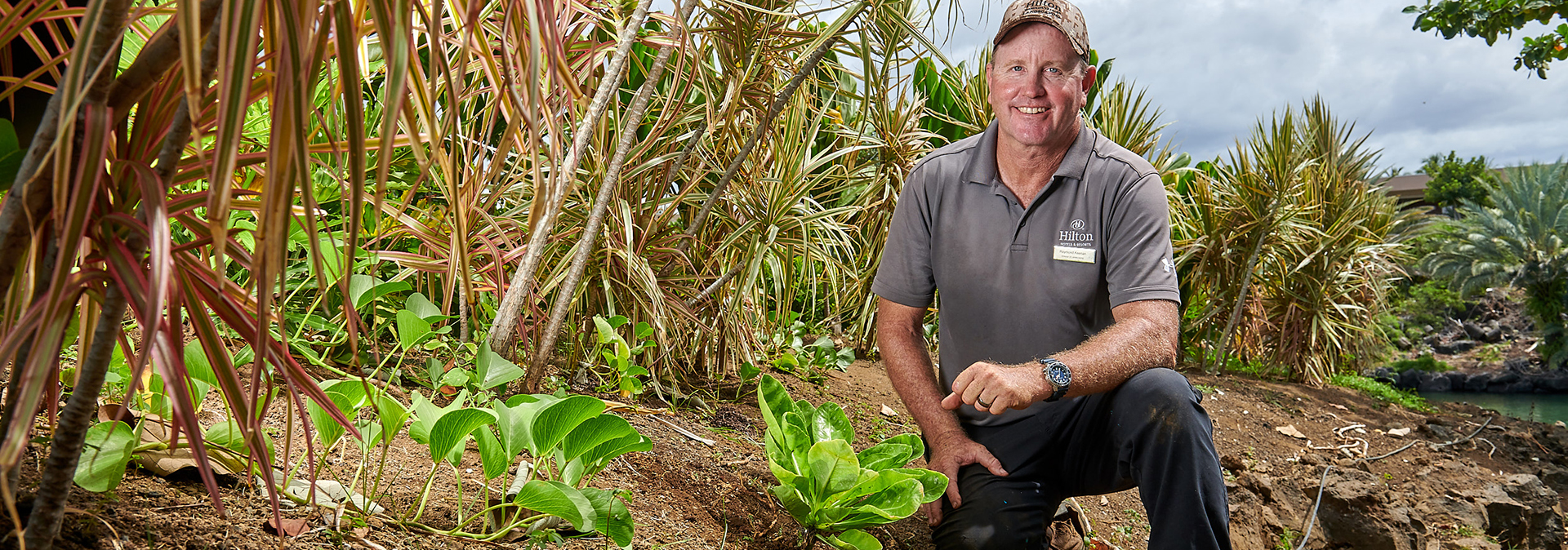Native plants are not only beautiful, but they often serve valuable, practical functions in their ecosystem. Hoping to serve as an industry model, Hilton Waikoloa Village has transformed its landscaping to revitalize native ecosystems.
Across 62 acres, the resort is cultivating rarely seen native species and restoring portions of an erosion-damaged National Historic Trail fronting the property.
The initiative will contribute to Hilton’s Travel with Purpose 2030 Goals, the company’s commitment to cutting its environmental footprint in half and doubling its social impact by 2030.
Today we meet Raymond Keenan, horticulture expert and director of landscaping at Hilton Waikoloa Village, who has been leading the charge in demonstrating the splendor, practicality, viability and sustainability of native plants.
You’re back in Hawaii doing what you love?
From a very young age I spent a lot of time outside, digging in the dirt or picking flowers on the lawn. I lived in Maui through high school and beyond, and that is where I recognized my interest in irrigation and horticultural techniques. I spent some time in Arizona, California and Florida learning various techniques, but ultimately I knew I wanted to come “home” to Hawaii. Everything I learned over the past 20 years was in preparation to work with the fascinating native plants in Hawaii.
Where did you find inspiration for your mission to introduce native plants on property?
While working on the mainland, I noticed that many hotels use non-native species in their landscaping. The same was true when I arrived at Hilton Waikoloa Village, but I was excited by the plants indigenous to the island and wanted to incorporate them on the property to help Guests better understand the local environment and cultural story when they visit. Like all plants, native plants initially require resource investment to get them established, but they are better adapted to our climate. Our native plants are drought tolerant, so over time they will require less water. With our proximity to the Pacific Ocean, we are also very mindful about preventing runoff of nitrogen and phosphorus, and these native plants require less fertilizer in order to be successful in this landscape.
What were your first steps in getting this effort off — or should we say “in” — the ground?
I reached out to different organizations to assist with the cultivation process. Fortunately, Hilton Waikoloa Village really supported this opportunity. We also experimented with different combinations to determine which native plants work well together in island-like groupings called kipuka, rather than in monoculture beds where a single kind of plant is grown. We have already found success with the 50 or so species we have introduced so far, so we are looking forward to integrating different native plants and inspiring others to do the same in their landscaping.
What hurdles do you face with the project?
The biggest challenge is trying to source these plants and navigate which native plants work well together. Across the state, few places are utilizing native plants in a major way in their landscaping, so there hasn’t been the demand for local nurseries to grow them. We have been starting that engine, creating the demand in our local economy for these products and working with local nurseries to deliver on the opportunity. We are even starting some of these plants ourselves from seeds or plant cuttings, working with partners in conservation.
What is the reaction to the new landscaping?
There is so much excitement surrounding the native plants. We have many Team Members and Guests asking questions about the different species and plants. This is such a great initiative to help everyone who visits our property gain a greater understanding of indigenous plants in our region.
What’s your ideal outcome for this project; where do you see it going?
Once we fully integrate the native plants onto the property, we will offer Guest tours. We also hope to share our learnings and the value of native landscaping with other businesses and organizations. We are also using native plants beyond our property in watershed projects led by the Hawaii State Division of Forestry and Wildlife, which is the recipient of an inaugural Hilton Effect Grant awarded by The Hilton Effect Foundation. We recently volunteered with one of these watershed projects at Kohala, a volcanic mountain in Hawaii. The team planted barren areas to restore the natural habitat and increase water conservation.








